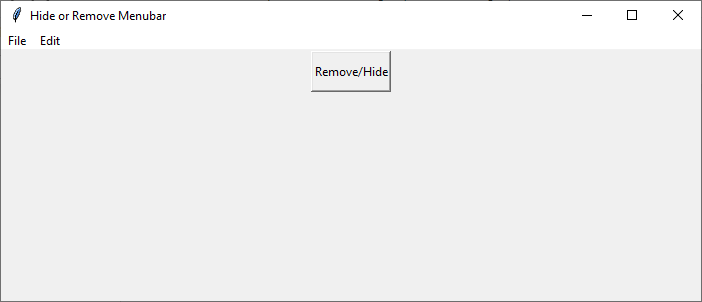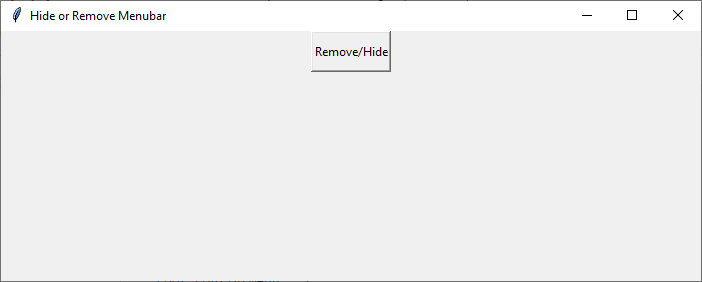
 Data Structure
Data Structure Networking
Networking RDBMS
RDBMS Operating System
Operating System Java
Java MS Excel
MS Excel iOS
iOS HTML
HTML CSS
CSS Android
Android Python
Python C Programming
C Programming C++
C++ C#
C# MongoDB
MongoDB MySQL
MySQL Javascript
Javascript PHP
PHP
- Selected Reading
- UPSC IAS Exams Notes
- Developer's Best Practices
- Questions and Answers
- Effective Resume Writing
- HR Interview Questions
- Computer Glossary
- Who is Who
Hide or removing a menubar of Tkinter in Python
Tkinter is a powerful and popular GUI (Graphical User Interface) toolkit for Python. It provides a set of widgets and functions to create visually appealing and interactive applications. One essential component of any GUI application is the menubar, which typically contains menus and commands that allow users to navigate and interact with the application. However, there are scenarios where you may want to hide or remove the menubar altogether. In this article, we will explore how to achieve this in Tkinter Python.
By default, Tkinter creates a menubar at the top of the application window, which includes the standard "File," "Edit," "View," and other menus. The menubar can be useful for providing easy access to various application functionalities. However, in some cases, you may want to hide or remove it to create a more streamlined or specialized user interface.
To hide or remove the menubar in Tkinter, we need to understand the structure of a typical Tkinter application. Tkinter uses a hierarchical structure where the menubar is part of the application's main window. We can access and modify the menubar by using the "menu" attribute of the main window object.
To begin, let's import the necessary modules and create a basic Tkinter window
#Import the necessary libraries
import tkinter as tk
#Create the Tkinter application
root = tk.Tk()
# Set the geometry of Tkinter Frame
root.geometry("720x250")
#Set the title of Tkinter Frame
root.title("Hide or Remove Menubar")
Now, let's create a menu bar with some menus and add it to the main window:
# Create a menubar menubar = tk.Menu(root) # Add a menu to the menubar file_menu = tk.Menu(menubar, tearoff=0) file_menu.add_command(label="New") file_menu.add_command(label="Open") file_menu.add_separator() file_menu.add_command(label="Exit", command=root.quit) edit_menu = tk.Menu(menubar, tearoff=0) edit_menu.add_command(label="Cut") edit_menu.add_command(label="Copy") edit_menu.add_command(label="Paste") menubar.add_cascade(label="File", menu=file_menu) menubar.add_cascade(label="Edit", menu=edit_menu) # Set the menubar on the main window root.config(menu=menubar)
In the code above, we create a menubar using the Menu class and associate it with the root window using the config(menu=menubar) method. We also create two menus, "File" and "Edit," and add them as cascading menus to the menubar using the add_cascade method. Each menu is created using the Menu class and populated with commands using the add_command method.
Now that we have created the menubar, let's explore how we can hide or remove it.
To completely remove the menubar from the window, we need to use the root.config method and set the menu attribute to " "
# Remove the menubar root.config(menu="")
By setting the menu attribute to " ", we detach the menubar from the window, effectively removing it. This approach is suitable when you want to create a custom user interface without any menu-based interactions.
It's important to note that once the menubar is hidden or removed, the user will no longer have access to the menus and commands it contains. Therefore, if you hide or remove the menubar, make sure to provide alternative methods for accessing the functionalities it offered. This could include keyboard shortcuts, context menus, toolbar buttons, or any other user interface elements that are appropriate for your application.
Example
Let's put everything together and see the complete code for hiding and removing the menubar
#Import the necessary libraries
import tkinter as tk
#Create the Tkinter application
root = tk.Tk()
# Set the geometry of Tkinter Frame
root.geometry("720x250")
#Set the title of Tkinter Frame
root.title("Hide or Remove Menubar")
# Create a menubar
menubar = tk.Menu(root)
# Add a menu to the menubar
file_menu = tk.Menu(menubar, tearoff=0)
file_menu.add_command(label="New")
file_menu.add_command(label="Open")
file_menu.add_separator()
file_menu.add_command(label="Exit", command=root.quit)
edit_menu = tk.Menu(menubar, tearoff=0)
edit_menu.add_command(label="Cut")
edit_menu.add_command(label="Copy")
edit_menu.add_command(label="Paste")
menubar.add_cascade(label="File", menu=file_menu)
menubar.add_cascade(label="Edit", menu=edit_menu)
# Set the menubar on the main window
root.config(menu=menubar)
# Function to remove the menubar
def remove_func():
root.config(menu="")
remove_button = tk.Button(root, text="Remove/Hide", command=remove_func, width=10, height=2)
remove_button.pack()
# Run the Tkinter event loop
root.mainloop()
Output
Running the above code will display a Tkinter window containing a menu bar with two menu items namely File and Edit.

In the above code we have also created a button named Remove/Hide. When you click on the button, it will hide the menu bar as shown below

Conclusion
Tkinter empowers developers with the flexibility to manage the menubar in Python GUI applications. Whether you need to temporarily hide it or permanently remove it, Tkinter provides simple methods to achieve your desired user interface design. By utilizing these techniques judiciously, you can craft customized and intuitive applications that align with your users' requirements. With Tkinter's capabilities, you have the freedom to create visually appealing interfaces while ensuring seamless functionality and a satisfying user experience. Take advantage of Tkinter's features to optimize the menubar and elevate the overall usability of your Python applications.

